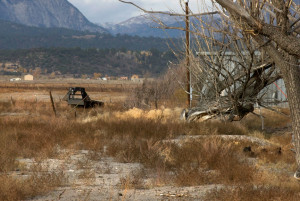By Virginia McConnell Simmons
While I was reading about African elephants, I wondered about certain differences and resemblances between elephant and human families.
In Louisa May Alcott’s well-known Little Women, Marmee goes on at Orchard House, wisely and gently tending to her brood while Father is far away doing man things. Anthropologists would call Marmee’s family matrilocal – a mother with her own children – although Father does return happily in Alcott’s story, thus making it a conjugal or nuclear family in the end.
Innately, elephants do what works best for elephants, and what works best is a herd consisting of one matriarch with her three or four female offspring, plus their progeny. Their gestation period is 22 months (oh lordy!), and they may live to be about 60 or 70 years old; so each herd, totaling about 6-12, is pretty well acquainted.
When the girls move from one place to another – as they must do often because an adult eats about 500 pounds of vegetation and drinks about 50 gallons of water each day – the matriarch is the one who makes the decision to move. (Their ivory tusks, coveted by human predators, are elongated incisor teeth, much longer in males than in females; and trunks are tools, not mouths.) The matriarch leads her herd, which follows her in an orderly procession, with small ones holding on to the tail ahead, saving their pushing and shoving for fun time.
Perhaps a young female may assume she too is cut out to eventually be a matriarch. According to an anecdote, while one such young elephant was walking in a line with caretakers one day, she unceremoniously shoved a visitor out of the way and onto his knees. So there!
When males finally reach adolescence, they are pushed out of the herd or just leave, mercifully for all. The guys then may join a male gang or their siblings, but seldom rove alone. Although they may seem docile, when one is provoked by someone or something, the bull lets out an earth-shattering roar, extends its ears and rears up, bringing down its massive weight with its feet and knees, squashing the victim.
What have interested me most about elephants are verifiable facts and anecdotes about their apparent feelings of concern for their young, their compassion, and their desire to alleviate one another’s suffering – traits that are shared with humans, at least when humans are at their best.
When a herd is in danger of attack, adults form a circle with the young gathered in the middle for protection.
When an elephant dies or is killed, the others try to cover it with dirt and foliage and linger for a few days of mourning. They may return to the site many years later.
In one instance, when poachers had killed an elephant mother and had grievously wounded her baby, the orphan was brought to the David Sheldrick Wildlife Trust in Kenya. The other young patients laid their trunks across the orphan’s back, as if to comfort her.
The same article by Charles Siebert in National Geographic magazine (September 2011) offered several other anecdotes about behavior at the shelter. When one young elephant at the holding center was able to return to the wild, she bore a child out there but later made a visit as if to show off her baby. The mother stood outside the fence making a terrific racket until she and the baby were allowed to enter and stroll around in front of the others. Then she and her baby departed, back to the wild.
What makes elephants behave as they do? Scientists tell us that although elephants’ brains are proportionately much smaller than a human’s, emotions and empathy develop in comparable parts of human and elephant brain mass. And like monkeys and dolphins, elephants rank high among animals in intelligence. As evidence, elephants can recognize their own images, as few animal species are able to do.
An elephant may not be as brainy as you and I are, but we seem to have more things in common with elephants than we might wish to admit. It makes you wonder who was made in whose image.
Virginia McConnell Simmons writes history, newspaper columns and book reviews from the San Luis Valley. Widely traveled, she knows firsthand what an elephant looks like after it is killed by poachers.

